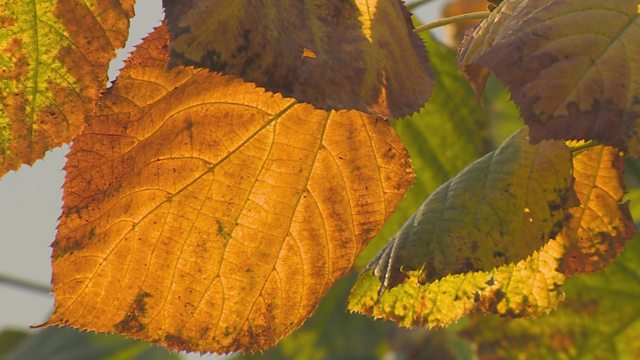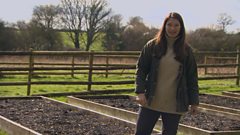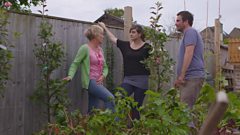
Episode 28
Gardening magazine. Find out how Rachel de Thame got on over the past year as she attempted to grow her own cut flowers. Carol Klein helps first-time gardeners in Gloucestershire.
In the first of four films, we find out how Rachel de Thame got on over the past year as she attempted to grow her own cut flowers.
Carol Klein helps first-time gardeners Dan and Dominique plant up a range of tasty fruit in their new garden in Gloucestershire.
And if you're still in a quandary about what to grow in your winter pots this year, Monty Don may well have the answer.
Last on
Clips
-
![]()
Rachel’s cut flower diary (Part 1)
Duration: 05:21
-
![]()
Planting cordon apples
Duration: 02:48
Cordon fruit

Cordons are a great way of fitting several different kinds of fruit into a small space. Apples, pears, gooseberries and redcurrants can all be trained into this shape – a main stem with short fruiting branches all along it. Most apple varieties can be made into cordons. The only exceptions are those that have the unusual habit of carrying their fruit at the tips of their branches. When buying them, check with an expert that they are not ‘tip-bearing’.
The four apple varieties Dan and Dom chose are listed below. They all ripen at different times to provide fruit over a long season but because they all flower at around the same time, they will all pollinate each other.
James Grieve - ripens early September, a good cooker and eater
Sunset – ripens late September, very reliable and prolific
Laxton’s Superb – ripens in October with crisp white flesh
Red Falstaff – crisp, juicy and good for storing, best picked in October. Â
For apple cordons, look for plants grafted onto an M9 rootstock which is semi-dwarfing. This gives them enough vigour to cover a fence but not so much that they’ll take over your garden.
Dan and Dom bought two and three year old plants, which were already trained as cordons, but it’s just as easy to start with very young trees that are sold bare-rooted in winter. Look for ‘feathered maidens’ – one-year-old trees with a single stem and a few side branches. Planted on a 45 degree angle, these will soon send out more side-shoots that can be shortened over the years to form short spurs that will eventually carry fruit.
Pruning of cordons is usually done in late summer but if you’re planting in winter, you can shorten any long branches right away. Leave the top unpruned until it reaches the height of your fence.
(www.rhs.org.uk)
Jobs for the weekend: Plant autumn onion sets
October is a good time to plant autumn onion sets. You can plant them directly outside, but Monty often plants them individually in plugs when the ground is too wet or when there simply isn’t enough space. Bury each one just half deep in the compost and give them a water. They don’t need any heat, just somewhere sheltered where they can start to sprout.
(www.rhs.org.uk)
Jobs for the weekend: Clean your greenhouse
It’s a good idea to give your greenhouse a good clean before the winter, as this will help to allow more light in and keep pests and diseases at bay. All you need is some hot water and a little detergent. Rinse it off, then leave it to dry.
(www.rhs.org.uk)
Jobs for the weekend: Repair bare patches in lawns
If you have a bare patch on your lawn, there is still time to repair it. Give the bare patch a vigorous scratch with a spring tine rake and then thinly sprinkle some grass seed over the surface. Because the ground is still warm, it will germinate quickly and be ready to grow strongly next spring.
(www.rhs.org.uk)
Credits
| Role | Contributor |
|---|---|
| Presenter | Monty Don |
| Presenter | Carol Klein |
| Presenter | Rachel de Thame |
| Series Producer | Christina Nutter |
| Series Editor | Liz Rumbold |
Broadcasts
- Fri 10 Oct 2014 21:30Â鶹ԼÅÄ Two except Wales
- Sat 11 Oct 2014 18:00Â鶹ԼÅÄ Two Scotland
- Sat 11 Oct 2014 18:30Â鶹ԼÅÄ Two except Scotland & Wales
- Sat 11 Oct 2014 20:30Â鶹ԼÅÄ Two Wales
- Sun 12 Oct 2014 08:00
- Thu 23 Oct 2014 10:05


